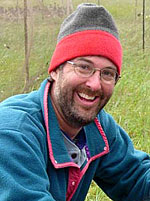Bird flu clues may lurk in Alaska wildfowl
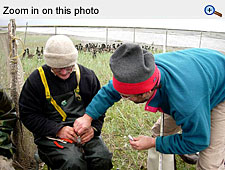
Jonathan Runstadler, right, and Jim Sedinger, former IAB director and now professor
at the University of Nevada Reno, take a swab from a Black Brant goose in Chevak,
Alaska.
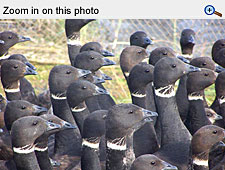
Black Brant geese in Chevak, Alaska are herded together before being tested as part
of the avian influenza program.
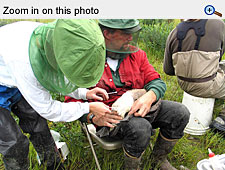
Heather Huson, UAF research technician, left, takes a swab of a Dusky Canada goose
as Mike Petrula, Alaska Department of Fish and Game Division of Wildlife Conservation,
looks on. Petrula agreed to participate in the avian influenza program as part of
his biennial banding project.
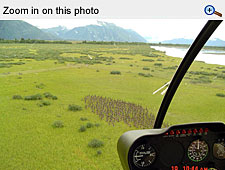
Dusky Canada geese are visible from a helicopter in the Copper River Delta near Cordova
July 18, 2005. Researchers took samples from the geese as part of the avian influenza
program.
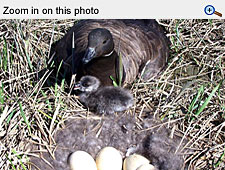
A Black Brant guards a gosling and a nest containing five eggs.
By Marie Gilbert, Institute of Arctic Biology
November 2005
Public health officials and researchers around the world are casting an increasingly uneasy eye toward migratory birds, especially in Alaska, following recent outbreaks of a deadly strain of avian influenza in other parts of the world.
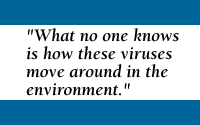 Alaska is at the overlap of the Asian and North American flyways for migratory birds.
Scientists say that could provide an opportunity for exchange of bird flu viruses
which could then infect humans. A deadly strain of bird flu virus has been detected
recently in Southeast Asia, Northwest China, Mongolia, Siberia, Kazakhstan, Tibet
and, most recently, Greece, Turkey and Romania.
Alaska is at the overlap of the Asian and North American flyways for migratory birds.
Scientists say that could provide an opportunity for exchange of bird flu viruses
which could then infect humans. A deadly strain of bird flu virus has been detected
recently in Southeast Asia, Northwest China, Mongolia, Siberia, Kazakhstan, Tibet
and, most recently, Greece, Turkey and Romania.
"What no one knows is how these viruses move around in the environment," said Jonathan Runstadler, veterinarian, assistant professor of biology and wildlife at the University of Alaska Fairbanks Institute of Arctic Biology and a lead scientist in the University of Alaska Program on the Biology and Epidemiology of Avian Influenza in Alaska.
The 1918 influenza virus which caused one of history's most deadly epidemics--an estimated 50 million people died and almost half of those who died were healthy, young adults--was identified in October of this year as a bird flu that jumped directly to humans. According to the National Institutes of Health, the virus currently circulating in Asia, a strain of the H5N1 subtype, has acquired five of the 10 gene sequence changes associated with the human-to-human transmission of the 1918 virus.
Scientists at UAF initiated the avian influenza project this summer to study the evolution and assess the prevalence of the many different avian influenza viruses in Alaska migratory birds, including the disease-causing H5N1 Asia subtype. Researchers sampled birds in the Yukon Flats and Yukon Delta national wildlife refuges, Copper River Delta, Minto Flats and other areas in the state.
"Infectious agents can move fast through the environment," Runstadler said. "California was excited about getting surveys on West Nile virus done before and then after the virus, but the virus got there before they could get baseline studies done. We're really happy we got this started this summer."
Roughly 4,500 cloacal samples were collected from migratory wildfowl this summer by Runstadler and collaborators from state, federal and private wildlife and public health agencies. Of the 4,500 samples, 290 have been screened to determine the presence of any of the known subtypes of bird flu viruses, but none of the analysis to date has detected the H5N1 of concern. The sample results will provide early detection for 2005 and baseline data for 2006 and subsequent years. UAF researchers and others can later use the information to compare samples they expect to collect annually and to help them build predictive models of how these viruses mutate and move in the environment.
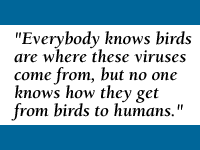 "We're trying to understand the evolution and prevalence of all avian influenza viruses in wild birds, not just H5N1--everybody knows birds are where
these viruses come from, but no one knows how they get from birds to humans," said
George Happ, director of the IDeA Network for Biomedical Research Excellence at UAF,
which provided start-up funding for the UA avian influenza program. "We want to identify
what genetic changes are important when a normally benign virus becomes a pathogen."
"We're trying to understand the evolution and prevalence of all avian influenza viruses in wild birds, not just H5N1--everybody knows birds are where
these viruses come from, but no one knows how they get from birds to humans," said
George Happ, director of the IDeA Network for Biomedical Research Excellence at UAF,
which provided start-up funding for the UA avian influenza program. "We want to identify
what genetic changes are important when a normally benign virus becomes a pathogen."
Although the avian influenza program is still receiving samples from collection sites around Alaska, they have sent more than 2,300 samples to the U.S. Armed Forces Institute of Pathology in Washington D.C. to be screened for the presence of avian influenza viruses. Samples which test positive will then be analyzed to determine their specific "H" and "N" subtype.
The screening at AFIP is being conducted by Jeffrey Taubenberger, the scientist who extracted and pieced together the viral genes from a lung-tissue sample obtained from a woman who died in Brevig Mission, Alaska, when influenza swept through the village in 1918, killing a handful of people. Taubenberger was also a member of one of the two teams of scientists who reported in October that the 1918 influenza was a bird flu that jumped to people.
The screening results from Alaska are not yet in. Runstadler speculates that they will not find H5N1 in their samples from this year but thinks they might next year. The birds that came to Alaska early this year probably were not yet exposed to the pathogenic H5N1 virus because they started their migration before the virus began to move. Next year may be a different story. The results from Alaska will be made public as soon as they are available.
"Not all H5N1s cause illness in humans as does the particular strain of H5N1 found in Southeast Asia," Runstadler said. "And this strain is changing all the time, so the specific sample, called an isolate, we get from the China H5N1 strain might be a little different from the isolate we get from the Mongolia H5N1 strain by 'x' number of DNA base pairs because of mutation. Both isolates might well behave the same or might behave slightly different.
 "The obvious question to ask if someone tells me they found H5N1 in a mallard from
Minto Flats is 'What's it related to? Is it like the Asian H5N1 that killed people
or like H5N1s found elsewhere that haven't affected humans?'"
"The obvious question to ask if someone tells me they found H5N1 in a mallard from
Minto Flats is 'What's it related to? Is it like the Asian H5N1 that killed people
or like H5N1s found elsewhere that haven't affected humans?'"
If Runstadler's prediction is correct, this summer's baseline information will provide researchers with a valuable before-H5N1 picture of avian influenza in Alaska's wildfowl population--information critical to building predictive models of how viruses work and move around in the natural world.
"We'll also be able to use this information to be better prepared to produce vaccines to particular strains, to develop treatment or containment strategies or to prevent viral introductions into poultry," Runstadler said.
"No one knows if H5N1 is going to be a pandemic or epidemic problem or if it's just going to fade away," Runstadler said.
"If it fades away there will be another virus that will be an issue. I don't know when--maybe next year, maybe 20 years or 30 years from now. There's going to be one that becomes human-adapted for transmission and it's going to make people sick," Runstadler said. "Hopefully by then we'll have better health-care systems and a better understanding of the biology of the virus so that we'll be able to effectively contain an epidemic and perhaps even predict its emergence and avoid it."
For more information, please contact:
- Jonathan Runstadler, assistant professor of molecular biology, Institute of Arctic Biology and Department of Biology and Wildlife, UAF, (907) 474-7038, jonathan.runstadler@uaf.edu
- George Happ, director Alaska IDeA Networks for Biomedical Research Excellence, UAF, (907) 474-5492, ffgmh@uaf.edu
- Marie Gilbert, publications and information coordinator, Institute of Arctic Biology, UAF, (907) 474-7412, marie.gilbert@uaf.edu
Useful links:
- Alaska IDeA Network for Biomedical Research Excellence (UAF)
- U.S. Centers for Disease Control avian influenza fact sheet
- World Health Organization avian influenza fact sheet
- National Institutes of Health, National Institute of Allergy and Infectious Diseases primer on the flu virus
- National Institutes of Health, National Institute of Allergy and Infectious Diseases October 2005 statement on the unmasking of the 1918 influenza virus
- National Public Radio programs about bird flu



